child lock MAZDA MODEL RX 8 2006 Owners Manual (in English)
[x] Cancel search | Manufacturer: MAZDA, Model Year: 2006, Model line: MODEL RX 8, Model: MAZDA MODEL RX 8 2006Pages: 434
Page 21 of 434
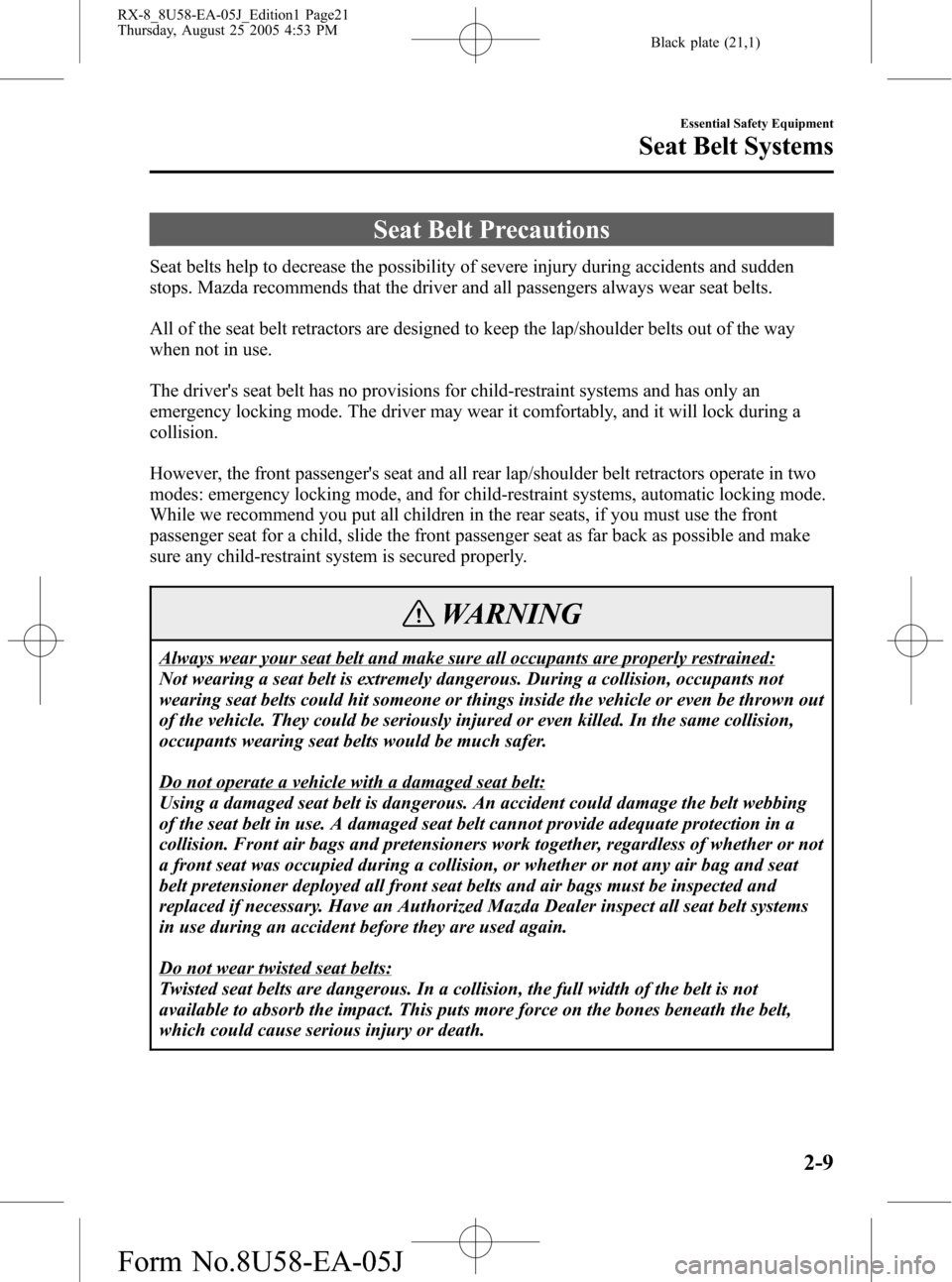
Black plate (21,1)
Seat Belt Precautions
Seat belts help to decrease the possibility of severe injury during accidents and sudden
stops. Mazda recommends that the driver and all passengers always wear seat belts.
All of the seat belt retractors are designed to keep the lap/shoulder belts out of the way
when not in use.
The driver's seat belt has no provisions for child-restraint systems and has only an
emergency locking mode. The driver may wear it comfortably, and it will lock during a
collision.
However, the front passenger's seat and all rear lap/shoulder belt retractors operate in two
modes: emergency locking mode, and for child-restraint systems, automatic locking mode.
While we recommend you put all children in the rear seats, if you must use the front
passenger seat for a child, slide the front passenger seat as far back as possible and make
sure any child-restraint system is secured properly.
WARNING
Always wear your seat belt and make sure all occupants are properly restrained:
Not wearing a seat belt is extremely dangerous. During a collision, occupants not
wearing seat belts could hit someone or things inside the vehicle or even be thrown out
of the vehicle. They could be seriously injured or even killed. In the same collision,
occupants wearing seat belts would be much safer.
Do not operate a vehicle with a damaged seat belt:
Using a damaged seat belt is dangerous. An accident could damage the belt webbing
of the seat belt in use. A damaged seat belt cannot provide adequate protection in a
collision. Front air bags and pretensioners work together, regardless of whether or not
a front seat was occupied during a collision, or whether or not any air bag and seat
belt pretensioner deployed all front seat belts and air bags must be inspected and
replaced if necessary. Have an Authorized Mazda Dealer inspect all seat belt systems
in use during an accident before they are used again.
Do not wear twisted seat belts:
Twisted seat belts are dangerous. In a collision, the full width of the belt is not
available to absorb the impact. This puts more force on the bones beneath the belt,
which could cause serious injury or death.
Essential Safety Equipment
Seat Belt Systems
2-9
RX-8_8U58-EA-05J_Edition1 Page21
Thursday, August 25 2005 4:53 PM
Form No.8U58-EA-05J
Page 23 of 434
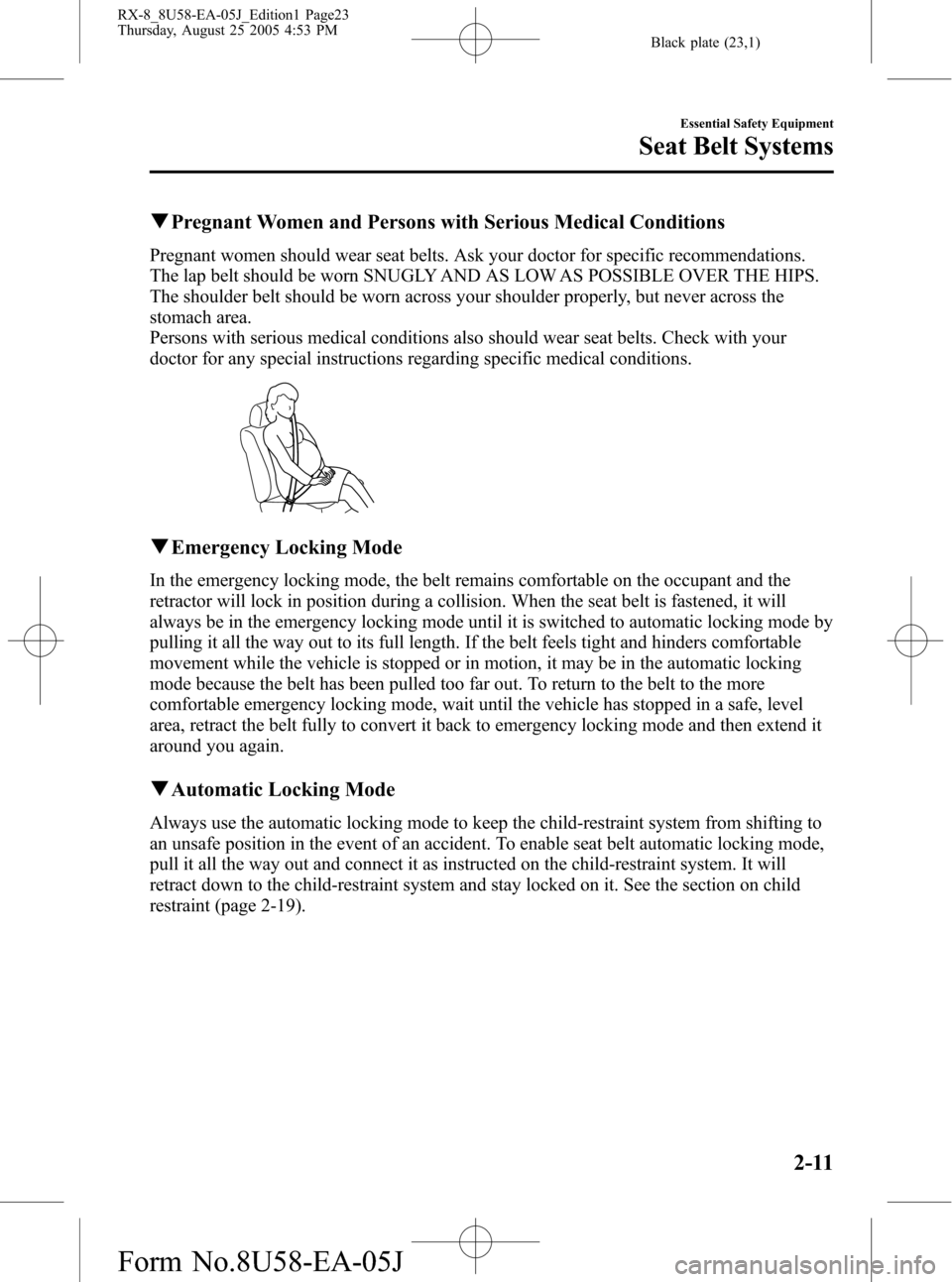
Black plate (23,1)
qPregnant Women and Persons with Serious Medical Conditions
Pregnant women should wear seat belts. Ask your doctor for specific recommendations.
The lap belt should be worn SNUGLY AND AS LOW AS POSSIBLE OVER THE HIPS.
The shoulder belt should be worn across your shoulder properly, but never across the
stomach area.
Persons with serious medical conditions also should wear seat belts. Check with your
doctor for any special instructions regarding specific medical conditions.
qEmergency Locking Mode
In the emergency locking mode, the belt remains comfortable on the occupant and the
retractor will lock in position during a collision. When the seat belt is fastened, it will
always be in the emergency locking mode until it is switched to automatic locking mode by
pulling it all the way out to its full length. If the belt feels tight and hinders comfortable
movement while the vehicle is stopped or in motion, it may be in the automatic locking
mode because the belt has been pulled too far out. To return to the belt to the more
comfortable emergency locking mode, wait until the vehicle has stopped in a safe, level
area, retract the belt fully to convert it back to emergency locking mode and then extend it
around you again.
qAutomatic Locking Mode
Always use the automatic locking mode to keep the child-restraint system from shifting to
an unsafe position in the event of an accident. To enable seat belt automatic locking mode,
pull it all the way out and connect it as instructed on the child-restraint system. It will
retract down to the child-restraint system and stay locked on it. See the section on child
restraint (page 2-19).
Essential Safety Equipment
Seat Belt Systems
2-11
RX-8_8U58-EA-05J_Edition1 Page23
Thursday, August 25 2005 4:53 PM
Form No.8U58-EA-05J
Page 34 of 434
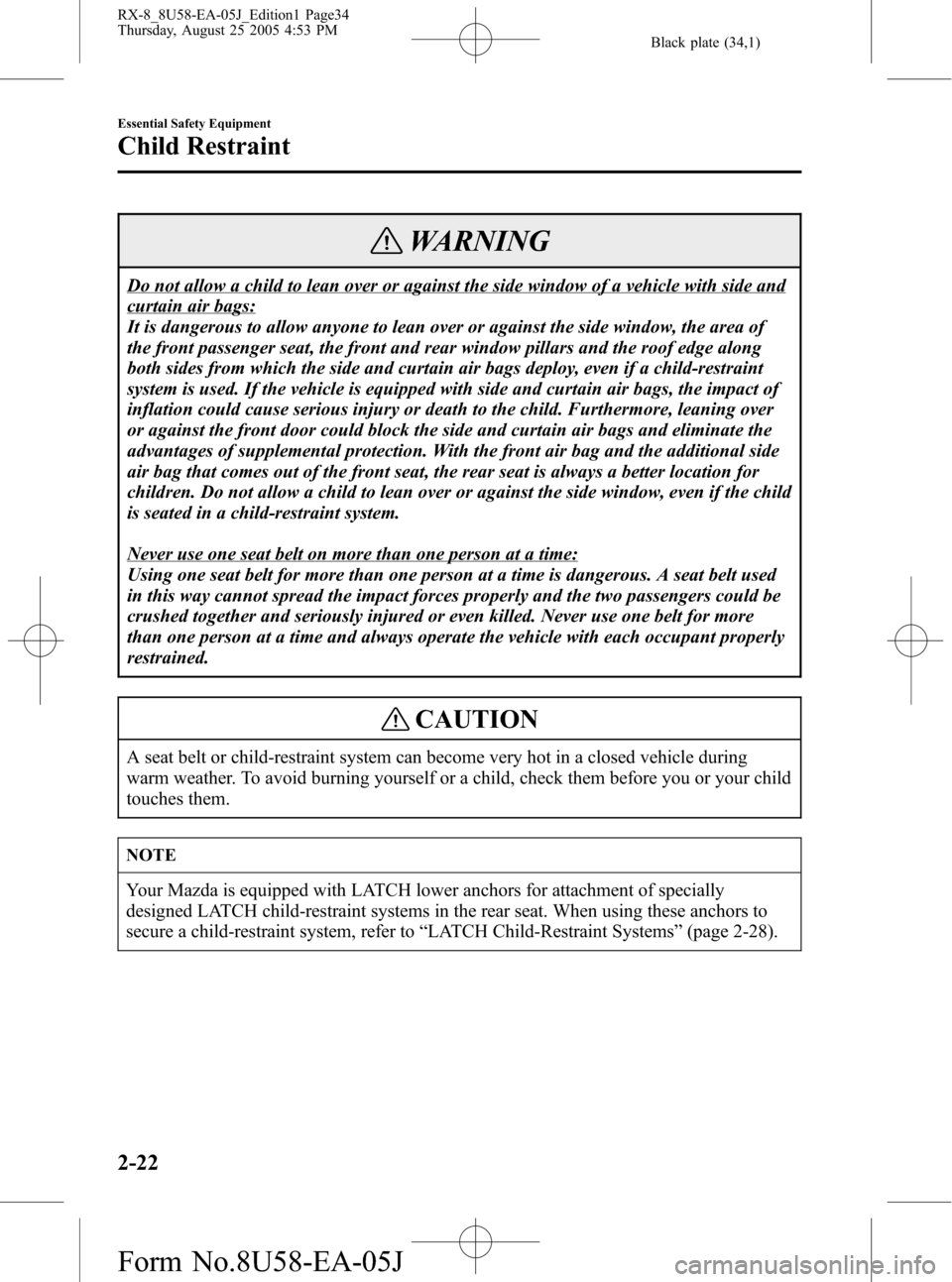
Black plate (34,1)
WARNING
Do not allow a child to lean over or against the side window of a vehicle with side and
curtain air bags:
It is dangerous to allow anyone to lean over or against the side window, the area of
the front passenger seat, the front and rear window pillars and the roof edge along
both sides from which the side and curtain air bags deploy, even if a child-restraint
system is used. If the vehicle is equipped with side and curtain air bags, the impact of
inflation could cause serious injury or death to the child. Furthermore, leaning over
or against the front door could block the side and curtain air bags and eliminate the
advantages of supplemental protection. With the front air bag and the additional side
air bag that comes out of the front seat, the rear seat is always a better location for
children. Do not allow a child to lean over or against the side window, even if the child
is seated in a child-restraint system.
Never use one seat belt on more than one person at a time:
Using one seat belt for more than one person at a time is dangerous. A seat belt used
in this way cannot spread the impact forces properly and the two passengers could be
crushed together and seriously injured or even killed. Never use one belt for more
than one person at a time and always operate the vehicle with each occupant properly
restrained.
CAUTION
A seat belt or child-restraint system can become very hot in a closed vehicle during
warm weather. To avoid burning yourself or a child, check them before you or your child
touches them.
NOTE
Your Mazda is equipped with LATCH lower anchors for attachment of specially
designed LATCH child-restraint systems in the rear seat. When using these anchors to
secure a child-restraint system, refer to“LATCH Child-Restraint Systems”(page 2-28).
2-22
Essential Safety Equipment
Child Restraint
RX-8_8U58-EA-05J_Edition1 Page34
Thursday, August 25 2005 4:53 PM
Form No.8U58-EA-05J
Page 35 of 434
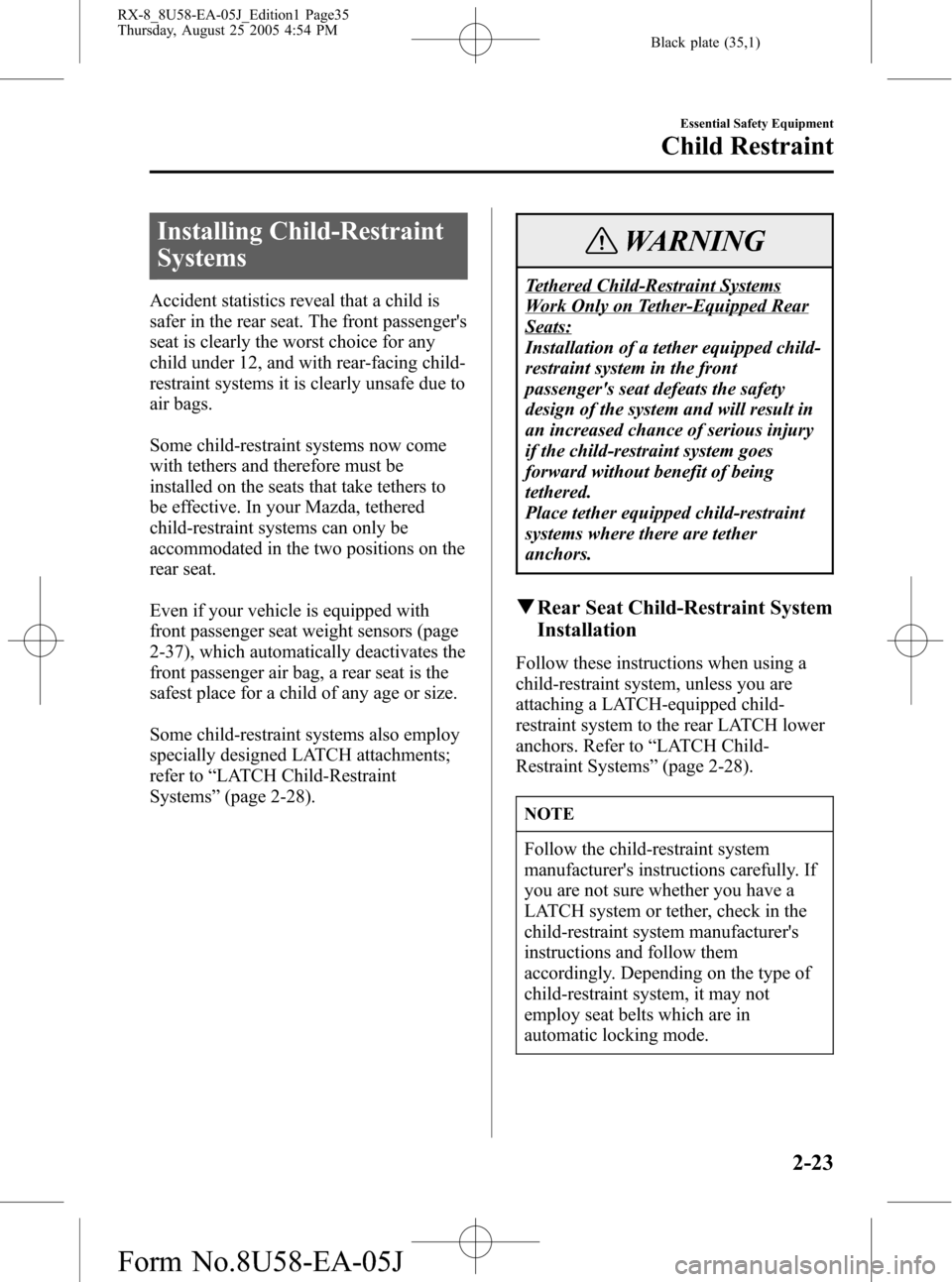
Black plate (35,1)
Installing Child-Restraint
Systems
Accident statistics reveal that a child is
safer in the rear seat. The front passenger's
seat is clearly the worst choice for any
child under 12, and with rear-facing child-
restraint systems it is clearly unsafe due to
air bags.
Some child-restraint systems now come
with tethers and therefore must be
installed on the seats that take tethers to
be effective. In your Mazda, tethered
child-restraint systems can only be
accommodated in the two positions on the
rear seat.
Even if your vehicle is equipped with
front passenger seat weight sensors (page
2-37), which automatically deactivates the
front passenger air bag, a rear seat is the
safest place for a child of any age or size.
Some child-restraint systems also employ
specially designed LATCH attachments;
refer to“LATCH Child-Restraint
Systems”(page 2-28).
WARNING
Tethered Child-Restraint Systems
Work Only on Tether-Equipped Rear
Seats:
Installation of a tether equipped child-
restraint system in the front
passenger's seat defeats the safety
design of the system and will result in
an increased chance of serious injury
if the child-restraint system goes
forward without benefit of being
tethered.
Place tether equipped child-restraint
systems where there are tether
anchors.
qRear Seat Child-Restraint System
Installation
Follow these instructions when using a
child-restraint system, unless you are
attaching a LATCH-equipped child-
restraint system to the rear LATCH lower
anchors. Refer to“LATCH Child-
Restraint Systems”(page 2-28).
NOTE
Follow the child-restraint system
manufacturer's instructions carefully. If
you are not sure whether you have a
LATCH system or tether, check in the
child-restraint system manufacturer's
instructions and follow them
accordingly. Depending on the type of
child-restraint system, it may not
employ seat belts which are in
automatic locking mode.
Essential Safety Equipment
Child Restraint
2-23
RX-8_8U58-EA-05J_Edition1 Page35
Thursday, August 25 2005 4:54 PM
Form No.8U58-EA-05J
Page 36 of 434
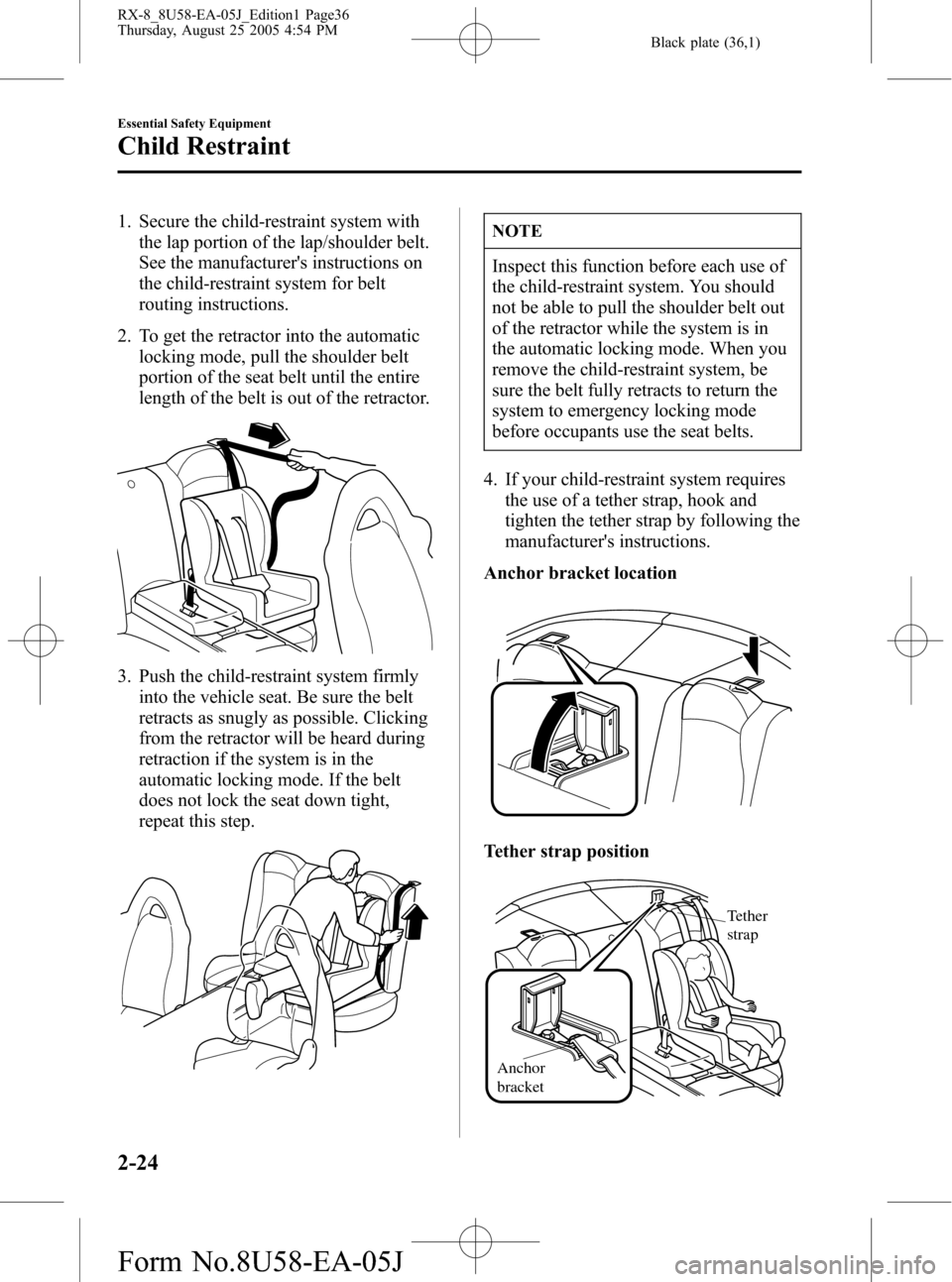
Black plate (36,1)
1. Secure the child-restraint system with
the lap portion of the lap/shoulder belt.
See the manufacturer's instructions on
the child-restraint system for belt
routing instructions.
2. To get the retractor into the automatic
locking mode, pull the shoulder belt
portion of the seat belt until the entire
length of the belt is out of the retractor.
3. Push the child-restraint system firmly
into the vehicle seat. Be sure the belt
retracts as snugly as possible. Clicking
from the retractor will be heard during
retraction if the system is in the
automatic locking mode. If the belt
does not lock the seat down tight,
repeat this step.
NOTE
Inspect this function before each use of
the child-restraint system. You should
not be able to pull the shoulder belt out
of the retractor while the system is in
the automatic locking mode. When you
remove the child-restraint system, be
sure the belt fully retracts to return the
system to emergency locking mode
before occupants use the seat belts.
4. If your child-restraint system requires
the use of a tether strap, hook and
tighten the tether strap by following the
manufacturer's instructions.
Anchor bracket location
Tether strap position
Anchor
bracketTether
strap
2-24
Essential Safety Equipment
Child Restraint
RX-8_8U58-EA-05J_Edition1 Page36
Thursday, August 25 2005 4:54 PM
Form No.8U58-EA-05J
Page 38 of 434
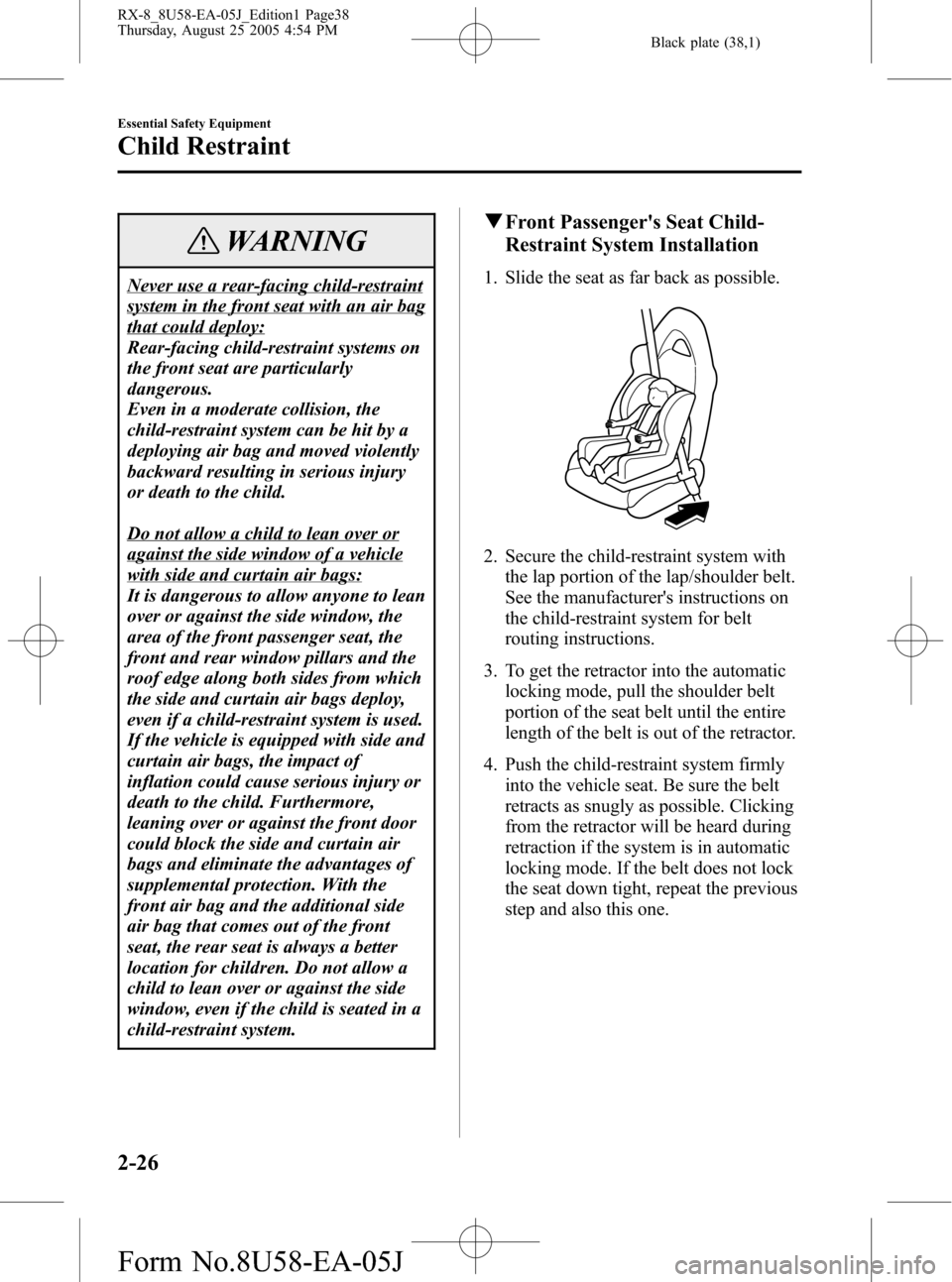
Black plate (38,1)
WARNING
Never use a rear-facing child-restraint
system in the front seat with an air bag
that could deploy:
Rear-facing child-restraint systems on
the front seat are particularly
dangerous.
Even in a moderate collision, the
child-restraint system can be hit by a
deploying air bag and moved violently
backward resulting in serious injury
or death to the child.
Do not allow a child to lean over or
against the side window of a vehicle
with side and curtain air bags:
It is dangerous to allow anyone to lean
over or against the side window, the
area of the front passenger seat, the
front and rear window pillars and the
roof edge along both sides from which
the side and curtain air bags deploy,
even if a child-restraint system is used.
If the vehicle is equipped with side and
curtain air bags, the impact of
inflation could cause serious injury or
death to the child. Furthermore,
leaning over or against the front door
could block the side and curtain air
bags and eliminate the advantages of
supplemental protection. With the
front air bag and the additional side
air bag that comes out of the front
seat, the rear seat is always a better
location for children. Do not allow a
child to lean over or against the side
window, even if the child is seated in a
child-restraint system.
qFront Passenger's Seat Child-
Restraint System Installation
1. Slide the seat as far back as possible.
2. Secure the child-restraint system with
the lap portion of the lap/shoulder belt.
See the manufacturer's instructions on
the child-restraint system for belt
routing instructions.
3. To get the retractor into the automatic
locking mode, pull the shoulder belt
portion of the seat belt until the entire
length of the belt is out of the retractor.
4. Push the child-restraint system firmly
into the vehicle seat. Be sure the belt
retracts as snugly as possible. Clicking
from the retractor will be heard during
retraction if the system is in automatic
locking mode. If the belt does not lock
the seat down tight, repeat the previous
step and also this one.
2-26
Essential Safety Equipment
Child Restraint
RX-8_8U58-EA-05J_Edition1 Page38
Thursday, August 25 2005 4:54 PM
Form No.8U58-EA-05J
Page 39 of 434

Black plate (39,1)
NOTE
lInspect this function before each use
of the child-restraint system. You
should not be able to pull the
shoulder belt out of the retractor
while the system is in the automatic
locking mode. When you remove the
child-restraint system, be sure the
belt fully retracts to return the system
to emergency locking mode before
occupants use the seat belts.
lFollow the child-restraint system
manufacturer's instructions carefully.
Depending on the type of child-
restraint system, it may not employ
seat belts which are in automatic
locking mode.
5. Make sure the front passenger air bag
deactivation indicator light illuminates
after installing a child-restraint system
on the front passenger seat.
Refer to Front passenger air bag
deactivation indicator light on page
2-37.
WARNING
Seating a Child in a Child-Restraint
System on the Front Passenger Seat
With the Front Passenger Air Bag
Deactivation Indicator Light Not
Illuminated:
While it is always better to install any
child-restraint system on the rear seat,
it is essential to do so if the front
passenger air bag deactivation
indicator light does not illuminate
(page 2-37). Seating a child in a child-
restraint system installed on the front
passenger seat with the front
passenger air bag deactivation
indicator light not illuminated is
dangerous. If this indicator light does
not illuminate even when the total
seated weight is less than
approximately 30 kg (66 lb), this
means that the front passenger front
and side air bags, and seat belt
pretensioner are ready for deployment.
If an accident were to deploy an air
bag, a child sitting in the front
passenger seat could be seriously
injured or killed. If the indicator light
does not illuminate after installing a
child-restraint system on the front
passenger seat, install the child-
restraint system on the rear seat and
consult an Authorized Mazda Dealer
as soon as possible.
Essential Safety Equipment
Child Restraint
2-27
RX-8_8U58-EA-05J_Edition1 Page39
Thursday, August 25 2005 4:54 PM
Form No.8U58-EA-05J
Page 62 of 434

Black plate (62,1)
Advanced Keysí
The advanced keyless functions (advanced keyless entry and start system) enables the
following operations while the advanced key is being carried (page 3-7).
lLocking/unlocking the doors, opening the trunk lid, without operating the key.
lStarting the engine without operating the key.
The advanced key enables additional functions other than those with the advanced keyless
functions (page 3-14).
lThe following operations are possible using the keyless entry system from a distance
(Lock/Unlock/Trunk button/Panic button):
lLocking/unlocking the doors.lOpening the trunk lid.lTurning on the alarm.
lLocking/unlocking the doors, opening the trunk lid, or starting the engine using the
auxiliary key.
WARNING
Keys and Children:
Leaving children in a vehicle with the key is dangerous. This could result in someone
being badly injured or even killed. These new kinds of keys are fascinating to
children. They could play with power windows or other controls, or even make the
vehicle move. Don't leave the keys in your vehicle with children and keep them in a
place where your children will not find or play with them.
Use of Advanced Key Near Medical Equipment:
Radio waves from the advanced key may affect medical equipment such as
pacemakers. Before using the advanced key near people who use medical equipment,
ask the medical equipment manufacturer or your physician if radio waves from the
advanced key will affect the equipment.
NOTE
lThe driver must carry the advanced key to ensure the system functions properly.
lRefer to Immobilizer System (page 3-45) for information regarding keys and engine
starting.
l(With theft-deterrent system)
Refer to Theft-Deterrent System (page 3-51) for information regarding keys and the
prevention of vehicle and vehicle contents theft.
3-2
Knowing Your Mazda
íSome models.
Advanced Keyless Entry and Start System
RX-8_8U58-EA-05J_Edition1 Page62
Thursday, August 25 2005 4:54 PM
Form No.8U58-EA-05J
Page 82 of 434

Black plate (82,1)
Keys (without Advanced Key)
WARNING
Keys and Children:
Leaving children in a vehicle with the
key is dangerous. This could result in
someone being badly injured or even
killed. These new kinds of keys are
fascinating to children. They could
play with power windows or other
controls, or even make the vehicle
move. Don't leave the keys in your
vehicle with children and keep them in
a place where your children will not
find or play with them.
NOTE
lRefer to Immobilizer System (page
3-48) for information regarding keys
and engine starting.
l(With theft-deterrent system)
Refer to Theft-Deterrent System
(page 3-51) for information
regarding keys and the prevention of
vehicle and vehicle contents theft.
The keys operate all locks.
Key code number plate
Retractable
type key
A code number is stamped on the plate
attached to the key set; detach this plate
and store it in a safe place (not in the
vehicle) for use if you need to make a
replacement key.
NOTE
Write down the code number and keep
it in a separate safe and convenient
place, but not in the vehicle.
If your key is lost, consult your
Authorized Mazda Dealer and have
your code number ready.
Key extend/retract method (Retractable
type key)
To extend the key, press the release
button.
3-22
Knowing Your Mazda
Doors and Locks
RX-8_8U58-EA-05J_Edition1 Page82
Thursday, August 25 2005 4:54 PM
Form No.8U58-EA-05J
Page 88 of 434

Black plate (88,1)
CAUTION
Radio equipment like this is governed
by laws in the United States.
Changes or modifications not expressly
approved by the party responsible for
compliance could void the user's
authority to operate the equipment.
Door Locks
WARNING
Unattended Children and Pets:
Leaving a child or an animal
unattended in a parked vehicle is
dangerous. In hot weather,
temperatures inside a vehicle can
become high enough to cause brain
damage or even death. Always take all
children and animals with you or
leave a responsible person with them.
Keys and Children:
Leaving children in a vehicle with the
key is dangerous. This could result in
someone being badly injured or even
killed. They could play with power
windows or other controls, or even
make the vehicle move. Don't leave the
keys in your vehicle with children and
keep them in a place where your
children will not find or play with
them.
Unlocked Doors:
Unlocked doors in a moving vehicle
are dangerous. Passengers can fall out
if a door is accidentally opened and
can more easily be thrown out in an
accident. So keep all doors locked
when driving.
3-28
Knowing Your Mazda
Doors and Locks
RX-8_8U58-EA-05J_Edition1 Page88
Thursday, August 25 2005 4:54 PM
Form No.8U58-EA-05J